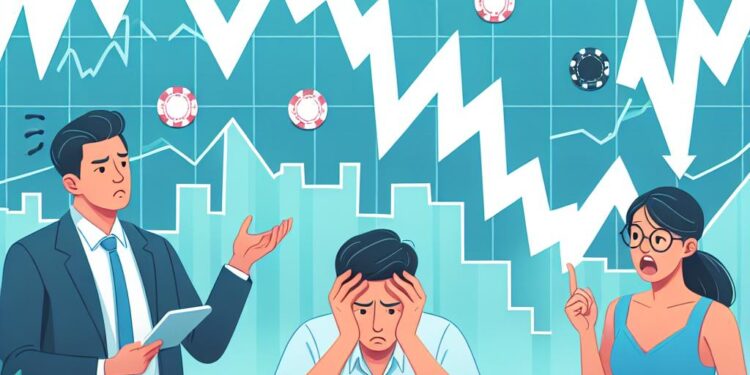Short selling might sound like betting against the market, but it’s actually a savvy investment strategy when approached correctly. For those aiming to enhance their financial planning and investment strategy, understanding short selling can truly amplify long-term wealth and financial security. However, let’s face it—many folks shy away due to common misconceptions, like thinking it’s too risky or only for financial wizards. The truth? With the right knowledge and approach, short selling can offer unique opportunities. In this blog, we’ll dive into practical tips and solutions to demystify short selling, empowering you to make informed decisions and navigate the market confidently.
What Is Short Selling? Betting Against the Market
Imagine short selling as betting on a racehorse to lose instead of win. In the financial world, it’s a bit like playing the odds that a stock’s price will decline. Short selling involves borrowing shares of a stock, selling them at the current high price, and then hoping to buy them back at a lower price, pocketing the difference. It might sound a tad pessimistic, but it’s a valid investment strategy when you believe a company’s stock is overpriced or its business prospects are dim. Think of it as anticipating a storm before the sun shines again. Short selling fits into personal finance as a way to potentially profit when the market downturns, adding a different dimension to one’s investment arsenal. However, it’s not for the faint of heart; it demands thorough research, solid risk management, and an understanding of market cycles. It’s one tool in the wealth-planner’s toolkit but must be used wisely.Why Short Selling Matters in Market Dynamics
Short selling is a complex financial concept that’s crucial for investors to grasp because it involves profiting from a decline in a stock’s price. Understanding short selling is important as it carries significant risks, such as potentially unlimited losses, which can impact an investor’s overall strategy. By becoming aware of how short selling operates, you can better navigate market dynamics, recognize potential market downturn signals, and protect your investment portfolio. It’s a key tool used by experienced traders to hedge or profit in bearish markets, contributing to a deeper comprehension of how sophisticated investment strategies function.How Does Short Selling Work?
- Identify a Stock: Investors start by selecting a stock they believe will drop in price. Imagine spotting a fashion item that’s trendy now but you think will soon go out of style.
- Borrow and Sell: The investor borrows shares of this stock from a broker and sells them at the current market price. It’s like borrowing that trendy item from a shop with the intention to return it later.
- Wait for the Price Drop: As the stock price falls, the investor can buy back the shares at the lower price. Think of waiting for the item to go on sale.
- Buy Back and Return: Once the shares are bought back, they’re returned to the broker, fulfilling the borrowing agreement. It’s akin to buying the item on discount and returning it to the shop.
- Realise the Profit: The difference between the sell and buy-back prices is the profit made, excluding fees and interest. This is the money saved when returning the item after buying it cheaper.
“Short Selling: Uncovering the Benefits and Risks Financially”
| Benefits | Risks/Disadvantages |
|---|---|
|
|
Practical Insights: How Short Selling Shapes Modern Financial Markets
Sure, let’s dive into how short selling, or betting against the market, is used.-
Hedge Funds: These large investment funds often use short selling to hedge against other investments, reducing overall risk. For example, during economic downturns, smart short selling can protect clients’ portfolios from larger losses.
-
Retail Investors: Some savvy individual investors use short selling to profit from expected declines in specific stocks. They closely monitor market trends and financial news to make informed decisions.
-
Market Correction: Short selling contributes to market correction by highlighting overvalued stocks. It can force companies to maintain ethical standards and disclose financial health accurately.
-
Cautionary Tale: In early 2021, certain hedge funds faced huge losses betting against GameStop, as a group of passionate retail investors used social media to drive the stock price up, showcasing the potential risks of short selling.
Comparing Short Selling to Traditional Investment Strategies: A Guide
| Aspect | Short Selling | Options Trading | Buying Put Options |
|---|---|---|---|
| Risk Level | High, as losses can be unlimited | Moderate to high, depending on strategy | High, but losses are capped |
| Return Potential | Potentially high if stock price falls | Variable, can be high with correct strategy | Limited to the invested amount in puts |
| Liquidity | Generally high, involves borrowing | Varies based on the options market | Depends on option market liquidity |
| Time Horizon | Short to medium term | Flexible, based on expiration dates | Depends on option expiration, typically shorter |
Mastering Finance for Modern Freelancers: Boost Your Wealth Wisely
– Tech-Savvy Millennials: This group, comfortable with technology and keen on financial markets, often opts for short selling. They’re eager to explore innovative strategies and leverage the tools at their disposal.– Risk-Tolerant Investors: Individuals who have a high risk appetite may use short selling to diversify their portfolios. They’re not afraid to take bold steps for potentially higher returns.
– Early Retirees: Those looking to supplement their income during retirement might consider short selling. It offers them an opportunity to stay engaged with the market and achieve financial goals.
Always analyse your risk tolerance before diving into short selling. Keep an eye on market trends, stay informed, and be prepared for potential losses. Stay disciplined, never gamble with essential funds.
Future Prospects in Short Selling Strategies
Short selling is constantly evolving. Here’s a peek into its future direction:- Technological Advances: With sophisticated trading algorithms, investors can analyze massive datasets at lightning speed. This precision boosts decision-making, helping traders better predict market downturns.
- Regulatory Changes: Governments worldwide are eyeing new policies. These might tighten short-selling regulations to ensure market stability, making the practice more transparent and safer for everyone involved.
- Market Trends: A rise in socially responsible investing could impact short selling. Traders might focus on companies with questionable practices or those that perform poorly in environmental, social, and governance (ESG) criteria.














